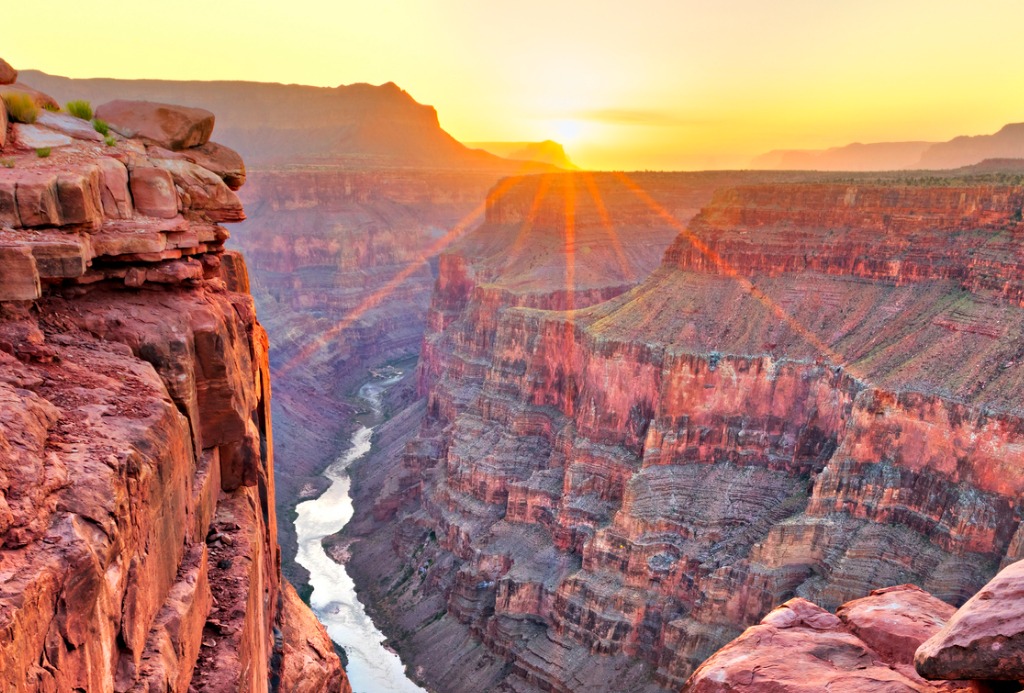Much like the Seven Wonders of the World, there are numerous lists compiling the Seven Natural Wonders of the World. This list combines the best of the New 7 Wonders of Nature and the Seven Natural Wonders organization. These breathtaking destinations have been chosen for their uniqueness and awestriking splendour. Note that natural sites don’t stick to man-made country borders, and so often are a part of two or more countries.
Aurora Borealis

Also known as the Polar Lights, or the Northern Lights, these natural displays of light are produced when the Earth’s magnetic field is disturbed by solar particles. They are seen in high-altitude regions and are called the Aurora Australis in the southern hemisphere. There are many places where you can view the Polar Lights.
Dead Sea

This massive salt lake is bordered by Israel, Palestine and Jordan. At 430 metres below sea level, it has the lowest elevation of any place on Earth. Its high levels of salinity (almost 10 times as salty as the ocean) make for a harsh environment where plants and animals don’t flourish. It is nonetheless rich in minerals and being among the 7 natural wonders of the world, has attracted visitors for thousands of years. However, in recent years the sea has been shrinking at an alarming rate.
Grand Canyon

Carved by the Colorado River in Arizona over millennia, this steep-sided canyon displays two billion years of geological history. Over 400 kilometres long, and almost 2,000 kilometres deep. The canyon and its many caves are full of Native American settlements. It is the only one of these seven natural wonders that have been inhabited for centuries.
Great Barrier Reef

Located off the coast of Queensland, Australia, this is the largest coral reef system in the world. With over 2,900 individual reefs, it stretches for over 2,300 kilometres. It is the biggest single structure made by living organisms, and can even be seen from outer space. However the Great Barrier Reef, one of the most colourful places in the world, is under threat of coral bleaching, so make sure to visit responsibly.
Mount Everest

The highest mountain above sea level, Mount Everest in the Himalayas is known as Sagarmatha in Nepali and as Chomolungma in Tibetan. Its elevation is currently officially recognised as 8,848 meters. Located between Nepal, Tibet, and China, the mountain attracts many climbers as it is one of the seven wonders of the world. However, those aiming for the summit must be highly experienced mountaineers and in peak physical condition. There are significant hazards from avalanches, weather, and wind.
Sundarbans

This vast unique coastal forest is located in the Bay of Bengal. It is famous for its mangrove forest, which covers over 10,000 square kilometres. Spread across parts of Bangladesh and West Bengal in India, it is home to many protected and endangered species, including the Bengal tiger. Despite it being illegal to harm wildlife (apart from fishing) this region has faced growing damage to the ecosystem.
Victoria Falls

Located in southern Africa, this enormous waterfall is on the border between Zambia and Zimbabwe. Created by the Zambezi River, Victoria Falls may not be the highest nor the widest waterfall in the world but is still said to be the largest. This is because its height (108 metres) and width (1,708 metres) combine to make it the world’s largest sheet of falling water. It is only rivalled by Iguazu Falls in Argentina and Brazil
Bonus: Amazon River

The mighty Amazon River is among the largest and longest rivers in the world. The Amazon basin, created by its many tributaries covers an area of about 7,500,000 square kilometres, almost half the South American continent. Along its banks is the Amazon rainforest, the largest rainforest in the world. Covering parts of Bolivia, Brazil, Colombia, Ecuador, Guyana, Peru, Suriname and Venezuela, it represents almost half of the planet’s remaining rainforests.


